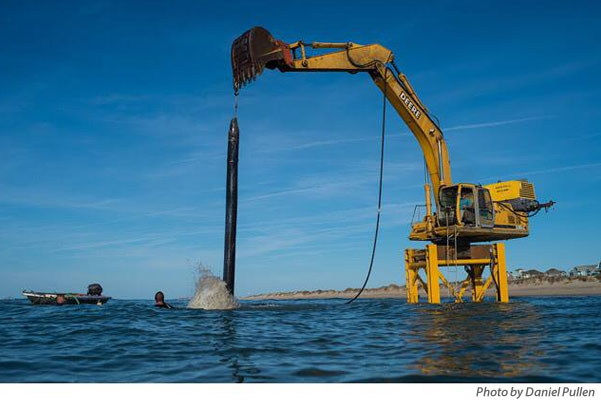The contractor for the removal of the Frisco (aka Cape Hatteras) Pier has enlisted some heavy duty equipment to tackle the underwater pilings that remain close to shore, and to adapt to the rough weather that has been prevalent in the past few months.
Using a large piece of equipment called a custom modified excavator that has been adjusted for the project, DOT Construction has been systematically removing pilings from the roots, with the assistance of trained divers.
“We have a very good contractor that’s been working on the [removal project], and they’ve done a great job of adapting to the weather conditions,” said David Hallac, Cape Hatteras National Seashore Superintendent. “The seas were quite rough this winter, and it was hard to implement the original plan.”
“However, they found a piece of equipment that can do a better job of getting the nearshore pilings out, and they have made quite a bit of progress. They have taken several dozen pilings out so far [with this method.]”
The removal of the Frisco Pier began in December 2017, starting with the Pier House itself, as well as the on-the-beach structures and pilings, which took just a couple weeks at most to complete.
The hard part of the project was always tackling the pilings that were located in the ocean waters. The pier was originally 20 feet wide and 500 feet long, with a total of 263 pilings that needed to be removed during the course of the project.
Of these 263 pilings, 120 are completely hidden as they have broken off beneath the water’s surface.
It was safety concerns of debris both in the water and washing ashore that prompted the project, which was first proposed in 2013. And while the pier itself has completely disappeared from the Frisco shoreline, the beach will continue to be a popular public access spot.
The original plan for the underwater pilings was to enlist teams of divers to address these submerged structures, however this labor-intensive portion of the project was dependent on good weather conditions – something that has been rare on Hatteras Island in the past few months.
By utilizing the custom modified excavator along with the divers, however, the project has not been as dependent on continually calm seas.
“[The excavator] is being used in conjunction with the divers, and it’s a better way to pull the pilings up once the divers loosen the sediment around the pilings,” said Hallac.
The custom modified excavator can only work in depths of 15 feet, however, so alternative methods will be utilized to address any pilings in deeper waters. Though progress has been steadily made since work began in December, it is likely that the removal will continue into the fall.
The removal project will have to pause for the summer season on May 11, due to the potential impact on sea turtle nesting season. However, it can resume again in the fall, after the season is over.
“We may not remove all the pilings by May 11, due to the weather we’ve had so far [this year],” said Hallac. “So we’ll likely come back in September to finish up the removal.”









